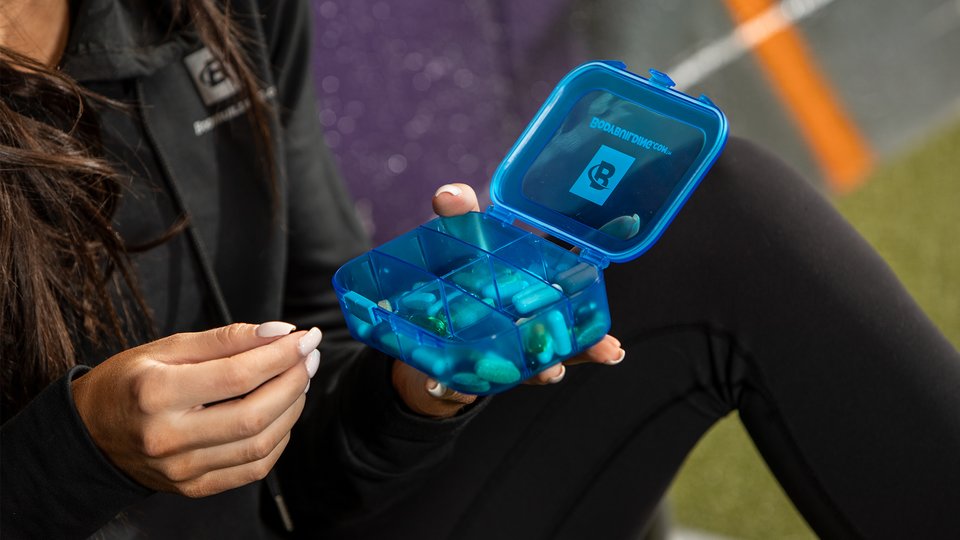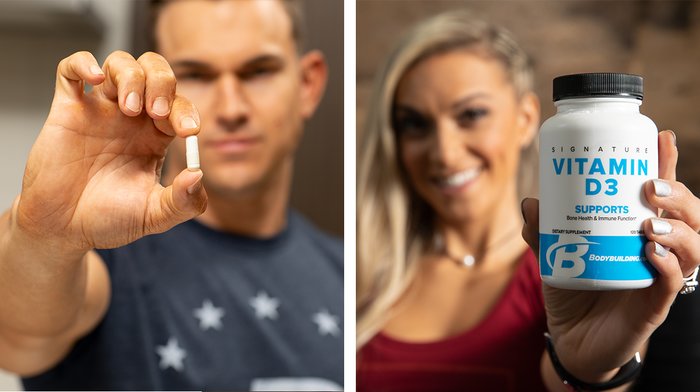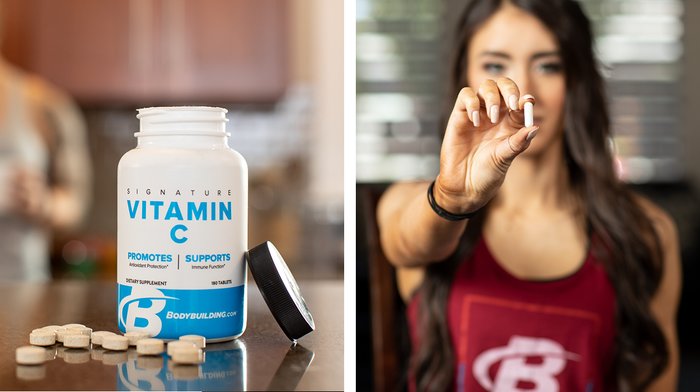Products You May Like
It’s tempting to look at the label on your supplements and think that the number listed there is exactly how much of the main ingredient your body will be able to use. Unfortunately, that’s not the case! Even in the best of circumstances, you’re never going to absorb or utilize 100 percent of a supplement. But there are ways you can help “activate,” absorb, or utilize the supplements you take—including taking them with other supplements that have been shown to help them do their thing.
Here are two instances of where you can boost the efficiency of the popular supplements vitamin D and collagen by stacking them with the right ingredients.
Vitamin D: Better with Magnesium
Vitamin D is an extremely important nutrient within the body, responsible for things like maintaining strong bones and supporting a healthy immune system. For many, consumption of foods high in vitamin D or supplementing with vitamin D products is necessary to achieve the recommended daily allowance of 600 IU or about 15 micrograms.[1] Since vitamin D is created in your skin thanks to the help of sunlight, those who live in states and countries that receive little sun during the winter may consider making vitamin D a focus in their dieting plans.
However, vitamin D supplementation may be improved by the introduction of another ingredient: magnesium.[2] Magnesium is one of the five most abundant minerals in the body alongside others such as sodium, potassium, calcium, and chloride—but it’s also one that people are chronically low in. It helps with hundreds of enzymatic reactions to support cell function, DNA and RNA synthesis, extracellular calcium levels, and importantly, modulates the activation of vitamin D within the body.[3]
Here’s what “activation” means here: When you consume vitamin D, it isn’t used as-is. It needs to be “hydroxylated” into its active form in either the liver or kidneys. Magnesium plays a key role in this activation through use as a co-factor in the vitamin D binding proteins as well as being required in the process of hydroxylation. Without it, vitamin D supplementation would be significantly less effective.
This beneficial relationship works in the other direction, too: Vitamin D supplementation can also help support the body’s ability to absorb magnesium.[4] The activated form of vitamin D, known as 1,25(OH)2D, can stimulate magnesium absorption in the intestines. And magnesium comes with its own laundry list of benefits, including supporting bone and muscle function among many others.
While it’s important to remember that consumption of these products won’t keep you from getting sick, they are both vital parts of balanced diet and exercise plans. This is especially true if you live in the northern regions of North America, Europe, and Asia.
Collagen Peptides: Better with Vitamin C
Collagen as a supplement is becoming more popular all the time. Many people are only now discovering how versatile the supplement can be in how you consume it, but also how important it is to daily health. No other protein in the body is as common as collagen. It makes up skin, tendons, ligaments, and many other structures. But absorbing it is a more complex process than you might realize.
When you consume any type of protein, much of it is going to be broken down into its subsequent amino acids. This allows the body to use those amino acids, and, more often than not, that use is likely related to building or repairing tissue. Unfortunately, collagen synthesis is no simple matter. There are many steps between free amino acids and functioning collagen.
One of those steps involves our old friend vitamin C! You may already be taking this staple vitamin and antioxidant for its immune-supporting qualities, but it turns out it’s also an essential component in collagen synthesis.
Here’s how: Once the three-dimensional structure of collagen is created, it is called “procollagen.” This means that it’s almost active, but not quite. At this stage, collagen needs to go through hydroxylation (see a trend here?). Hydroxylation, in this case, is the act of replacing lone hydrogens on the exposed proline and lysine amino acids with hydroxyl groups (an oxygen and hydrogen bonded). This hydroxylation allows for a later step called glycosylation which is what gives collagen its functional helix structure.[5]
If there’s no vitamin C around, there’s no hydroxylation. No hydroxylation means no glycosylation. No glycosylation means no functioning collagen. Funny enough, there’s actually a name for this condition: scurvy!
If you’ve ever heard how sailors desperately sought out oranges, limes, and even potatoes back in the days of oceanic exploration, this is why. While many vitamins are merely co-factors for reactions and can be used multiple times, vitamin C is consumed in the process of collagen synthesis so it must be constantly replenished.[6] If sailors didn’t get a solid, constant source of vitamin C on their long voyages, they would start to experience symptoms of collagen loss due to lack of vitamin C.
Now, before you rush to the store to stave off scurvy, it’s important to understand that a standard diet already provides plenty of great sources of vitamin C to support healthy collagen synthesis. Focusing on eating citrus fruits, tomatoes, peppers, and many other fruits and veggies will keep your collagen synthesis running smoothly.
References
- Vitamin, D. (2019). Fact Sheet for Professionals. 2014. National Institute of Health, Office of Dietary Supplements.
- Uwitonze, A. M., & Razzaque, M. S. (2018). Role of magnesium in vitamin D activation and function. J Am Osteopath Assoc, 118(3), 181-189.
- Caspi, R., Foerster, H., Fulcher, C. A., Kaipa, P., Krummenacker, M., Latendresse, M., … & Walk, T. C. (2007). The MetaCyc Database of metabolic pathways and enzymes and the BioCyc collection of Pathway/Genome Databases. Nucleic Acids Research, 36(suppl_1), D623-D631.
- Swaminathan, R. (2003). Magnesium metabolism and its disorders. The Clinical Biochemist Reviews, 24(2), 47.
- Peterkofsky, B. (1991). Ascorbate requirement for hydroxylation and secretion of procollagen: relationship to inhibition of collagen synthesis in scurvy. The American Journal of Clinical Nutrition, 54(6), 1135S-1140S.
- Myllylä, R., Majamaa, K., Günzler, V., Hanauske-Abel, H. M., & Kivirikko, K. I. (1984). Ascorbate is consumed stoichiometrically in the uncoupled reactions catalyzed by prolyl 4-hydroxylase and lysyl hydroxylase. Journal of Biological Chemistry, 259(9), 5403-5405


